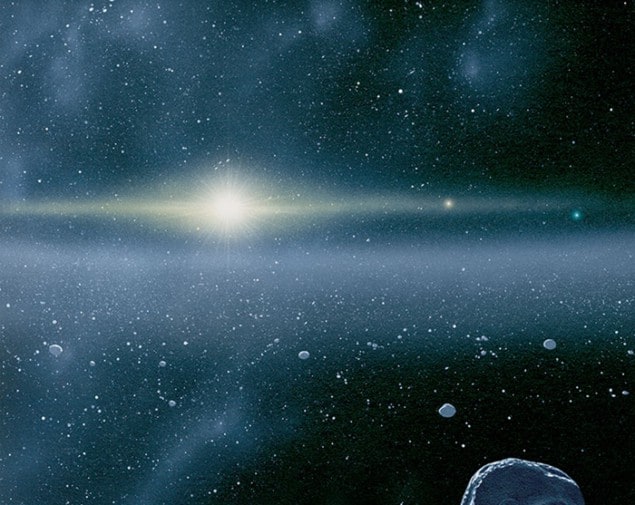
A dwarf-planet candidate called UX25 and its tiny satellite could provide the first evidence of a new cosmological model that includes antigravity, say Alberto Vecchiato and Mario Gai of the Astrophysical Observatory of Turin in Italy. The model dispenses with concepts such as dark matter, dark energy and cosmic inflation, and the astronomers say that it could be tested by observing the motion of the two objects as they move through the outer solar system.
In 1915 Albert Einstein’s fledgling general theory of relativity received a major credibility boost when it was used to explain a discrepancy in Mercury’s orbit that could not be accounted for by Newtonian physics alone. Now, nearly a century later, Vecchiato and Gai have calculated that UX25 and its tiny satellite – which orbit the Sun in the Kuiper belt beyond Neptune – could be used as a “natural laboratory” to test an ambitious new model of the universe.
Gravitational charges
Developed by CERN physicist Dragan Hajdukovic, the model is based upon the concept that empty space – also known as the quantum vacuum – is not really empty at all. Instead, it consists of “virtual” matter and antimatter particles that constantly blink in and out of existence. Hajdukovic’s idea is that these particles have opposing gravitational charges, similar to positive and negative electrical charges. He further predicts that in the presence of a gravitational field, virtual particles in the quantum vacuum will generate a secondary gravitational field that has an amplifying effect. The end result is that galaxies and other objects will appear to have stronger gravitational fields than would be predicted by the mass of their stars alone – a discrepancy that most astronomers explain by invoking the hypothetical and mysterious substance known as dark matter.
In Hajdukovic’s new model of the universe, there is also no need for dark energy, the enigmatic force that scientists think is causing the universe to expand at an accelerated rate. The idea is that if virtual particles have gravitational charges, then space–time itself can exert a kind of pressure that causes objects to repel each other. His theory would also negate the need for cosmic inflation, a theorized rapid swelling of the early universe when space–time itself expanded faster than the speed of light. “My theory provides encouraging initial answers to many different fundamental questions in physics,” says Hajdukovic.
Distant elliptical orbits
Hajdukovic has previously suggested that his theory could be tested if a minor planet with a small satellite that has an elliptical orbit can be found. The system would need to be located far from the Sun and other massive bodies.
Now, Vecchiato and Gai suggest that Hajdukovic’s model can be tested by using existing ground and space telescopes to observe the UX25 system – which is about 43 times farther from the Sun than is the Earth. “The properties of quantum vacuums described in Hajdukovic’s theory would apply an additional [gravitational] force on UX25, perturbing the orbit of the system,” Vecchiato explained to physicsworld.com.
Wobbling moon
Hajdukovic’s model predicts that the wobble, or “precession rate”, of UX25’s tiny moon around the dwarf planet should be larger than is predicted by classical physics. Where Newtonian physics predicts a precession rate of 0.0064 arc seconds – too small to be observed with current methods – Hajdukovic’s theory predicts that the rate should be 0.23 arc seconds per period – just enough to be detectable by NASA’s Hubble Space Telescope and the soon-to-be-launched James Webb Space Telescope.
According to Vecchiato and Gai, a large ground-based telescope such as the Very Large Telescope might also be able to make the necessary observations of UX25.
Evidence for Hajdukovic’s theory would result in a dramatic change in perspective for physicists, says Gai. “Most scientists today think quantum physics is mainly restrained to the microscopic world…In this case, the natural microscopic behaviour of empty space would result in a cumulative, long-range effect acting up to cosmic scales.”
The proposal appears on the arXiv preprint server.



